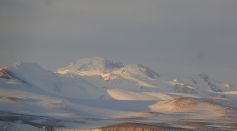ENVIRONMENT & CLIMATE

Mass Extinction Volcanic Eruption Wiped Out 90% of All Living Things 250 Million Years in the Past

Air Pollution Decrease in India During COVID-19 Lockdown Not as High as Originally Thought
Silent Killer: What Causes This Stony Coral Tissue Loss Disease That Has Inflicted More Than 20 Species?

Ancient Egyptian Artisans and Creations Discovered First-Ever in Tomb of Female Pharaoh; Graveyard Built Through Team Effort of Various Painters and Sculptors

Trees and Vegetation Wander to Cooler Places Due to Climate Shifts, Wildfires Accelerate Movements

Why Do Fishes Rub on Sharks? Intriguing Behavior May Have Ecological Function
Dinosaur Species Belonging to the Famous Iguanodon Group Found in the Isle of Wight; Uniqueness of Feature Identified in Teeth Count

Ocean Temperature Responsible for Maintaining Cooler Temperature in North America and Drying Other Regions of the Continent

Airborne Hydrogen Extraction Technique for Fuel, First Used by Bacterias in Antarctic
Plate Tectonics Weaken as They Sink; Research Reveals Pieces of Crust of Earth Bend Upon Entry in the Mantle

3 Dead, 500 Stung as Heavy Storms in Egypt Wash Scorpions Into Homes; How to Get Away With Scorpion Sting?

Speed of Human-Caused Global Warming Over the Last 150 Years Has Increased at a Level Not Seen Since the Last Ice Age

Blue Origin’s Jeff Bezos Predicts Earth Will Be a 'Natural Resort' and Only Few Will Be Allowed To Stay
Mineralogist Discovers Mineral 'Davemaoite' Trapped In a Diamond From Earth's Mantle
Most Popular

How the STEVE Phenomenon Creates a Strange Purple Aurora That Atmospheric Science Still Can't Fully Explain

How the 8 Smartest Animals Show Extraordinary Animal Intelligence and Cognitive Abilities

Could a Twin Sun or Solar Sibling Be Hiding Among Nearby Stars in Our Galaxy?

Surprising Climate Change Effects and Global Warming Signs Changing Your Daily Life Now





